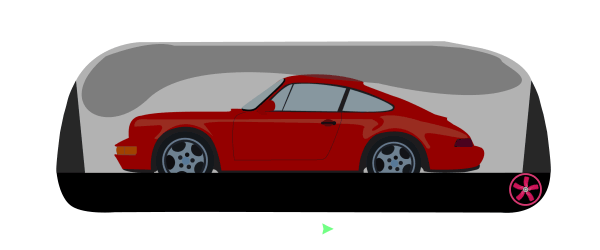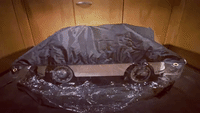How It Works
The Car Bubble works by using air to protect the vehicle inside of the Car Bubble. A constant flow of air is pushed into the Car Bubble, through a fan featuring a polyester reticulated foam filter, the filter has the perfect balance of allowing adequate air to flow through while stopping floating particulates from getting through to the inside of the Car Bubble.
Due to the constant flow of air, a consistent pressure is maintained within the bubble, which is more than enough to keep the Car Bubble inflated and ensure the air inside is never still, this is the key to protection. Still air, allows for moisture and particles to settle, once these settle, this is when rust and mould can develop. An isolated environment is created within the Car Bubble, this results in slower temperature changes which prevents condensation and ensures nothing harmful on the outside, get in. We have all come back to our garaged cars to find new spider webs!

The Car Bubble itself is enough to protect a vehicle inside, featuring PVC side panels, the PVC is thicker than your average car cover and will protect your paintwork. The PVC reinforced tarpaulin base mat, is enough to stop moisture rising through it while being tough enough to stand up to being driven on and off, even on rough surfaces. It is the thickest base mat available, purposely to ensure it lasts the longest.
If you happen to get caught in the rain or have just washed your car, you can still use the Car Bubble, a removable drying panel allows air to flow out at the opposite end to the fan, creating a flow of air over the car which helps dry your vehicle faster than leaving it outside.
If you are conscious about energy usage, in addition to our supplied variable voltage adapter, you can use a timer plug to activate the car bubble at sunset and deactivate at sundown, condensation is less likely to occur during the day time for a car which has remained contained within the Car Bubble, as long as the vehicle is clean, the PVC will not cause any harm to gently resting on the vehicle. Of course, the Car Bubble remains sealed and still works as a general protection device when deflated which is still better than any typical car cover. To avoid the top cover from resting on the vehicle, you can make use of the hook points which feature on each corner, this then prevents the top cover from resting on your vehicle.

Air flow
Cars are built to be on the move, designed to operate at their best when in motion. When parked in a garage, they lose the airflow that keeps their parts healthy. That’s where the magic of the Car Bubble comes in. It doesn’t make your car move; it makes the air move. With about 30,000 liters of air circulating through the smallest of spaces, your car stays in top shape, even when at rest.
Condensation
But what about condensation? In the Car Bubble, we control against rapid changes in climate, which are the primary cause of condensation. The air inside the Car Bubble is exchanged three times in an hour. So, even if there’s a rapid change in temperature outside, it takes about twenty minutes to affect the environment inside. This gradual change ensures that condensation does not occur.

Problems Solved
- Weather Protection: Car bubbles provide effective protection against various weather conditions, including rain, snow, hail, and UV rays. This ensures that your car remains in pristine condition regardless of the elements.
- Preservation of Vehicle Value: Storing your car in a bubble can help preserve its value over time. It prevents paint damage, rust, and corrosion, which can significantly impact a vehicle’s resale value.
- Dust and Debris Prevention: Car bubbles keep dust, dirt, leaves, and debris away from your car, reducing the need for frequent cleaning and detailing.
- Security: Car bubbles act as an additional layer of security, deterring potential thieves and vandals from accessing or damaging your vehicle.
- Long-Term Storage: Car bubbles are ideal for long-term storage, making them perfect for seasonal vehicles or collector cars that are not regularly driven.
- Convenience: Using a car bubble is convenient as it minimizes the effort required for cleaning and maintaining your car. It’s also easier to access and move your vehicle when needed.
- Protection from Insects and Pests: Car bubbles keep insects, rodents, and other pests away from your car, preventing potential damage and contamination.
- Interior Preservation: By maintaining a controlled environment around your car, bubbles help preserve the interior, including the dashboard, seats, and electronics, from UV damage and heat.
- Reduced Allergen Exposure: For individuals with allergies or sensitivities, car bubbles can help reduce exposure to pollen and airborne allergens that might accumulate on the car’s surface.
- Enhanced Aesthetics: Car bubbles keep your car looking great all year round, ensuring that it’s always ready for a drive or display.
- Peace of Mind: Knowing that your car is protected in a secure, controlled environment provides peace of mind, especially during extreme weather conditions or long periods of storage.
- Savings on Maintenance: By reducing the wear and tear caused by exposure to the elements, car bubbles can lead to savings on maintenance and repair costs.
The Car Bubble isolates a vehicle from the outside, preventing condensation, keeping dust, bugs, pets and rodents away. If you care for your vehicle, the Car Bubble is the ultimate protection for it!